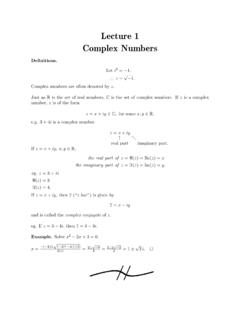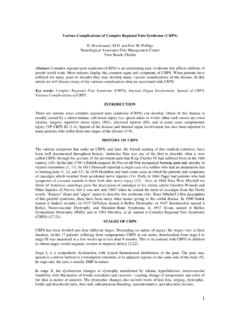Transcription of COMPLEX NUMBERS - Number theory
1 Chapter 5 COMPLEX Constructing the COMPLEX numbersOne way of introducing the fieldCof COMPLEX NUMBERS is via the arithmeticof 2 2 COMPLEX Number is a matrix of the form x yyx ,wherexandyare real NUMBERS of the form x00x are scalar matrices and are calledrealcomplex NUMBERS and are denoted by the symbol{x}.The real COMPLEX NUMBERS {x}and{y}are respectively called therealpartandimaginary partof the COMPLEX Number x yyx .The COMPLEX Number 0 11 0 is denoted by the have the identities x yyx = x00x + 0 yy0 = x00x + 0 11 0 y00y ={x}+i{y},i2= 0 11 0 0 11 0 = 1 00 1 ={ 1}.8990 CHAPTER 5. COMPLEX NUMBERSC omplex NUMBERS of the formi{y}, whereyis a non zero real Number , arecalledimaginary two COMPLEX NUMBERS are equal, we can equate their real andimaginaryparts:{x1}+i{y1}={x2}+i{y2} x1=x2andy1=y2,ifx1, x2, y1, y2are real NUMBERS .
2 Noting that{0}+i{0}={0}, gives theuseful special case is{x}+i{y}={0} x= 0 andy= 0,ifxandyare real sum and product of two real COMPLEX NUMBERS are also real complexnumbers:{x}+{y}={x+y},{x}{y}={xy} .Also, as real COMPLEX NUMBERS are scalar matrices, their arithmetic is verysimple. They form a field under the operations of matrix addition andmultiplication. The additive identity is{0}, the additive inverse of{x}is{ x}, the multiplicative identity is{1}and the multiplicative inverse of{x}is{x 1}. Consequently{x} {y}={x}+ ( {y}) ={x}+{ y}={x y},{x}{y}={x}{y} 1={x}{y 1}={xy 1}= xy .It is customary to blur the distinction between the real COMPLEX Number {x}and the real numberxand write{x}asx. Thus we write the complexnumber{x}+i{y}simply asx+ generally, the sum of two COMPLEX NUMBERS is a COMPLEX Number :(x1+iy1) + (x2+iy2) = (x1+x2) +i(y1+y2);( )and (using the fact that scalar matrices commute with all matrices undermatrix multiplication and{ 1}A= AifAis a matrix), the product oftwo COMPLEX NUMBERS is a COMPLEX Number :(x1+iy1)(x2+iy2) =x1(x2+iy2) + (iy1)(x2+iy2)=x1x2+x1(iy2) + (iy1)x2+ (iy1)(iy2)=x1x2+ix1y2+iy1x2+i2y1y2= (x1x2+{ 1}y1y2) +i(x1y2+y1x2)= (x1x2 y1y2) +i(x1y2+y1x2),( ) CALCULATING WITH COMPLEX NUMBERS91 The setCof COMPLEX NUMBERS forms a field under the operations ofmatrix addition and multiplication.
3 The additive identityis 0, the additiveinverse ofx+iyis the COMPLEX Number ( x) +i( y), the multiplicativeidentity is 1 and the multiplicative inverse of the non zerocomplex numberx+iyis the COMPLEX numberu+iv, whereu=xx2+y2andv= yx2+y2.(Ifx+iy6= 0, thenx6= 0 ory6= 0, sox2+y26= 0.)From equations and , we observe that addition and multiplicationof COMPLEX NUMBERS is performed just as for real NUMBERS , replacingi2by 1, whenever it useful identity satisfied by COMPLEX NUMBERS isr2+s2= (r+is)(r is).This leads to a method of expressing the ratio of two COMPLEX NUMBERS inthe formx+iy, wherexandyare real COMPLEX +iy1x2+iy2=(x1+iy1)(x2 iy2)(x2+iy2)(x2 iy2)=(x1x2+y1y2) +i( x1y2+y1x2)x22+ process is known asrationalization of the Calculating with COMPLEX numbersWe can now do all the standard linear algebra calculations over the field ofcomplex NUMBERS find the reduced row echelon form of an matrix whose el-ements are COMPLEX NUMBERS , solve systems of linear equations, find inversesand calculate example, solve the system(1 +i)z+ (2 i)w= 2 + 7i7z+ (8 2i)w= 4 coefficient determinant is 1 +i2 i7 8 2i = (1 +i)(8 2i) 7(2 i)= (8 2i) +i(8 2i) 14 + 7i= 4 + 13i6= 5.
4 COMPLEX NUMBERSH ence by Cramer s rule, there is a unique solution:z= 2 + 7i2 i4 9i8 2i 4 + 13i=(2 + 7i)(8 2i) (4 9i)(2 i) 4 + 13i=2(8 2i) + (7i)(8 2i) {(4(2 i) 9i(2 i)} 4 + 13i=16 4i+ 56i 14i2 {8 4i 18i+ 9i2} 4 + 13i=31 + 74i 4 + 13i=(31 + 74i)( 4 13i)( 4)2+ 132=838 699i( 4)2+ 132=838185 699185iand similarlyw= 698185+ important property enjoyed by COMPLEX NUMBERS is that every com-plex Number has a square root:THEOREM a non zero COMPLEX Number , then the equationz2=whas a so-lutionz Letw=a+ib, a, b 1. Supposeb= 0. Then ifa >0,z= ais a solution, while ifa <0,i ais a 2. Supposeb6= 0. Letz=x+iy, x, y R. Then the equationz2=wbecomes(x+iy)2=x2 y2+ 2xyi=a+ib,so equating real and imaginary parts givesx2 y2=aand 2xy= CALCULATING WITH COMPLEX NUMBERS93 Hencex6= 0 andy=b/(2x). Consequentlyx2 b2x 2=a,so 4x4 4ax2 b2= 0 and 4(x2)2 4a(x2) b2= 0.)
5 Hencex2=4a 16a2+ 16b28=a a2+ >0, so we must take the + sign, asa a2+b2<0. Hencex2=a+ a2+b22, x= sa+ a2+ determined byy=b/(2x).EXAMPLE the equationz2= 1 + Putz=x+iy. Then the equation becomes(x+iy)2=x2 y2+ 2xyi= 1 +i,so equating real and imaginary parts givesx2 y2= 1 and 2xy= 0 andy= 1/(2x). Consequentlyx2 12x 2= 1,so 4x4 4x2 1 = 0. Hencex2=4 16 + 168=1 + 22andx= s1 + 1 2p1 + the solutions arez= s1 + 22+i 2p1 + 2 .94 CHAPTER 5. COMPLEX NUMBERSEXAMPLE the equationz2+ ( 3 +i)z+ 1 = Because every COMPLEX Number has a square root, the familiarformulaz= b b2 4ac2afor the solution of the general quadratic equationaz2+bz+c= 0 can beused, where nowa(6= 0), b, c C. Hencez= ( 3 +i) q( 3 +i)2 42= ( 3 +i) q(3 + 2 3i 1) 42= ( 3 +i) p 2 + 2 we have to solvew2= 2 + 2 3i. Putw=x+iy. Thenw2=x2 y2+ 2xyi= 2 + 2 3iand equating real and imaginary parts givesx2 y2= 2 and 2xy= 2 3.
6 Hencey= 3/xand sox2 3/x2= 2. Sox4+ 2x2 3 = 0 and (x2+ 3)(x2 1) = 0. Hencex2 1 = 0 andx= 3. Hence (1 + 3i)2= 2 + 2 3iand the formula forznowbecomesz= 3 i (1 + 3i)2=1 3 + (1 + 3)i2or 1 3 (1 + 3) the cube roots of We have to solve the equationz3= 1, orz3 1 = 0. Nowz3 1 = (z 1)(z2+z+ 1). Soz3 1 = 0 z 1 = 0 orz2+z+ 1 = +z+ 1 = 0 z= 1 12 42= 1 there are 3 cube roots of 1, namely 1 and ( 1 3i) state the next theorem without proof. It states that everynon constant polynomial with COMPLEX Number coefficients has a root in thefield of COMPLEX GEOMETRIC REPRESENTATION OFC95 THEOREM (Gauss)Iff(z) =anzn+an 1zn 1+ +a1z+a0,wherean6= 0 andn 1, thenf(z) = 0 for somez follows that in view of thefactortheorem, which states that ifa Fisa root of a polynomialf(z) with coefficients from a fieldF, thenz ais afactor off(z), that isf(z) = (z a)g(z), where the coefficients ofg(z) alsobelong toF.
7 By repeated application of this result, we can factorize anypolynomial with COMPLEX coefficients into a product of linearfactors withcomplex coefficients:f(z) =an(z z1)(z z2) (z zn).There are available a Number of computational algorithms for finding goodapproximations to the roots of a polynomial with COMPLEX Geometric representation ofCComplex NUMBERS can be represented as points in the plane, using the cor-respondencex+iy (x, y). The representation is known as theArganddiagramorcomplex plane. The real COMPLEX NUMBERS lie on thex axis,which is then called thereal axis, while the imaginary NUMBERS lie on they axis, which is known as theimaginary axis. The COMPLEX NUMBERS withpositive imaginary part lie in theupper half plane, while those with negativeimaginary part lie in thelower half of the equation(x1+iy1) + (x2+iy2) = (x1+x2) +i(y1+y2), COMPLEX NUMBERS add vectorially, using the parallellogramlaw.
8 Similarly,the COMPLEX numberz1 z2can be represented by the vector from (x2, y2)to (x1, y1), wherez1=x1+iy1andz2=x2+iy2. (See Figure )The geometrical representation of COMPLEX NUMBERS can be very usefulwhen COMPLEX Number methods are used to investigate properties of trianglesand circles. It is very important in the branch of calculus known as ComplexFunction theory , where geometric methods play an mention that the line through two distinct pointsP1= (x1, y1) andP2= (x2, y2) has the formz= (1 t)z1+tz2, t R, wherez=x+iyisany point on the line andzi=xi+iyi, i= 1,2. For the line has parametricequationsx= (1 t)x1+tx2, y= (1 t)y1+ty2and these can be combined into a single equationz= (1 t)z1+ 5. COMPLEX NUMBERS - 6?z1 z2z1+z2z1z2 * @@@@R@@@@R Figure : COMPLEX addition and have various equation representations in terms of COMPLEX num-bers, as will be seen COMPLEX conjugateDEFINITION ( COMPLEX conjugate)Ifz=x+iy, thecomplexconjugateofzis the COMPLEX Number defined byz=x iy.
9 Geometrically,the COMPLEX conjugate ofzis obtained by reflectingzin the real axis (seeFigure ).The following properties of the COMPLEX conjugate are easy to +z2=z1+z2;2. z= z2=z1 z2; ;5.(1/z) = 1/z;6.(z1/z2) =z1/z2; COMPLEX CONJUGATE97- 6?xyzz >ZZZZ~Figure : The COMPLEX conjugate real if and only ifz=z;8. With the standard convention that the real and imaginary parts aredenoted by Rezand Imz, we haveRez=z+z2,Imz=z z2i;9. Ifz=x+iy, thenzz=x2+ (z) is a polynomial with real coefficients, then itsnon real roots occur in COMPLEX conjugate pairs, iff(z) = 0, thenf(z) = Supposef(z) =anzn+an 1zn 1+ +a1z+a0= 0, wherean, .. , a0are real. Then0 =0 =f(z) =anzn+an 1zn 1+ +a1z+a0=anzn+an 1zn 1+ +a1z+a0=anzn+an 1zn 1+ +a1z+a0=f(z).EXAMPLE the position of the roots of the equationz4= 1in the COMPLEX The equationz4= 1 has real coefficients and so its roots comein COMPLEX conjugate pairs.
10 Also ifzis a root, so is z. Also there are98 CHAPTER 5. COMPLEX NUMBERS clearly no real roots and no imaginary roots. So there must beone rootwin the first quadrant, with all remaining roots being given byw, wand w. In fact, as we shall soon see, the roots lie evenly spaced on the following theorem is useful in deciding if a polynomialf(z) has amultiple roota; that is if (z a)mdividesf(z) for somem 2. (The proofis left as an exercise.)THEOREM (z) = (z a)mg(z), wherem 2 andg(z) is apolynomial, thenf (a) = 0 and the polynomial and its derivative have acommon theorem we obtain a result which is very useful in the explicitintegration of rational functions ( ratios of polynomials) with real (z) is a non constant polynomial with real coeffi-cients, thenf(z) can be factorized as a product of real linear factors andreal quadratic In generalf(z) will haverreal rootsz1.












